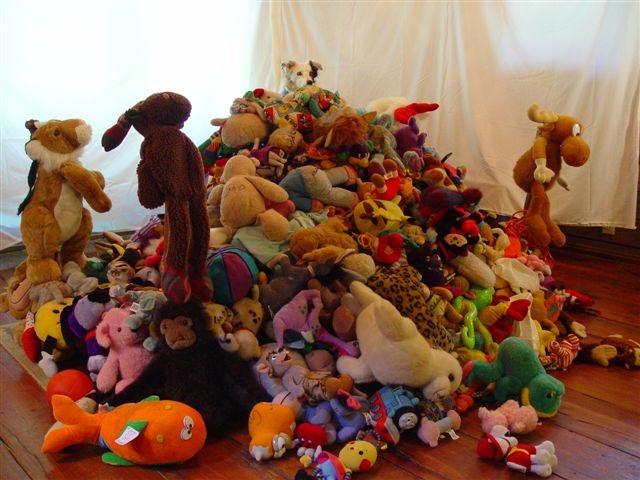Study shows dog’s "amazing" ability to comprehend language
You might think your pet has a lot of toys. But she definitely does not have as many toys as Chaser, a female border collie. Chaser has more than a thousand toys, and she can remember the names of all of them.
A recent study from South Carolina’s Wofford College details an extraordinary experiment in language comprehension and cognition in dogs. The researchers, retired psychology professor John Pilley, PhD, and psychology professor Alliston Reid, PhD, attempted to see if they could teach a dog (Chaser) to not only identify over a thousand objects, but if she could learn in a way similar to how human children learn. The study "Border collie comprehends object names as verbal referents," was published in the journal Behavioural Processes.
 |
| Chaser atop her mound of 1,022 toys. She learned the names of them all over a three-year period. (Photo by Robin Pilley) |
The study consisted of four experiments:
Experiment 1:
Over a three-year period with intensive training, Chaser was able to learn the names of 1,022 individual objects. The objects were a variety of toys, balls and Frisbees, and each was given a name (which was written on the object), such as lips, lamb, uncle fuzz, Santa Claus, etc."We know now that she comprehends that objects have names," said Pilley , who is also Chaser’s owner. "We assume that when we say ‘Santa Claus’ there’s a mental image of some type. Some way or another, that word evokes some kind of memory for that particular object."
Chaser was tested periodically to see how well she remembered the names, and she consistently demonstrated an impressive ability for memory. In over 800 trials, Chaser was asked to fetch 20 objects by name.
"She showed us 90 percent memory capacity," Pilley said. "She never failed to retrieve at least 18 out of the 20 correctly. That’s amazing. I can recall about one half of them – and I named the objects."
Experiment 2:
Chaser was instructed to interact with a set of toys in several different ways. She was told to take, nose or paw certain objects."Chaser had received extensive experience with these three commands directed toward other familiar objects, but she was able to combine these novel command–noun phrases accurately on the first trial without additional training," the study says. .Thus, after learning the meanings of the commands and the nouns, Chaser was able, as do children, to understand the novel combination of two-word phrases."
Experiment 3:
Pilley and Reid wanted to see if Chaser was able to form mental categories of objects based on their name. The experimenters divided all 1,022 objects into three categories "toy," "ball" or "Frisbee." With training, Chaser was able to identify balls and "Frisbees" from a collection of objects, and she was also able to identify toys among non-toy objects."If we think about the dog in the natural world, they see categories. They know the difference between dogs and cats. When they see a dog there’s a general type of behavior that comes out," Pilley said. "What we’ve demonstrated is that the dog not only understands the categories, but can associate a common word for those categories."
Experiment 4:
Perhaps the most interesting part of the study was where Chaser learned to identify objects by exclusion. For this experiment, a novel item was placed among a pile of familiar toys. When she was asked to retrieve the novel item by its name (which she was not familiar with), she successfully identified the novel item as the one desired by the experimenter and retrieved it. (Video of experiment 4)"That’s a mental inference," Pilley said. "Here we’ve got more evidence that she understands things and processes them mentally. She’s not an automatic reflex organism like some people believe. Exclusive learning demonstrates learning by a totally new method other than association, and by a method that very young infants use in learning words."
Next steps
Pilley said he is working on a series of new experiments that will test how much Chaser can understand. The published study showed that Chaser can understand a verb-noun combination. Now Pilley is attempting to see if she can understand added levels of syntax, such as a command to take one object to another object.
Pilley is also working with Chaser to see if she can learn to imitate behavior.
"If you go to teach a dog a behavior like turning around in a circle three times, you’re going to have to use what we call shaping techniques," Pilley said. "It’s going to take a long time to teach the dog that."
But, he said, if a dog can be taught to imitate a behavior, getting the dog to perform complicated actions can be simplified.
The key to training Chaser is adequate play time, which is the reward she enjoys the most, Pilley said. And out of all of her toys, what was Chaser favorite?
"I suppose ‘Blue,’ a racket- or hand-ball, is Chasers favorite," Pilley said. "Although, like kids, new toys are favored initially. Even later, all her toys seem to be appreciated. When old, familiar toys are presented to her, she always retrieves them and presents them additional play for several trials before seeking out another toy for play. Her memory for each of the toys highly suggest that all her toys have value."
More information:
Chaser with all of her 1,022 toys. (Photo by Robin Pilley)


